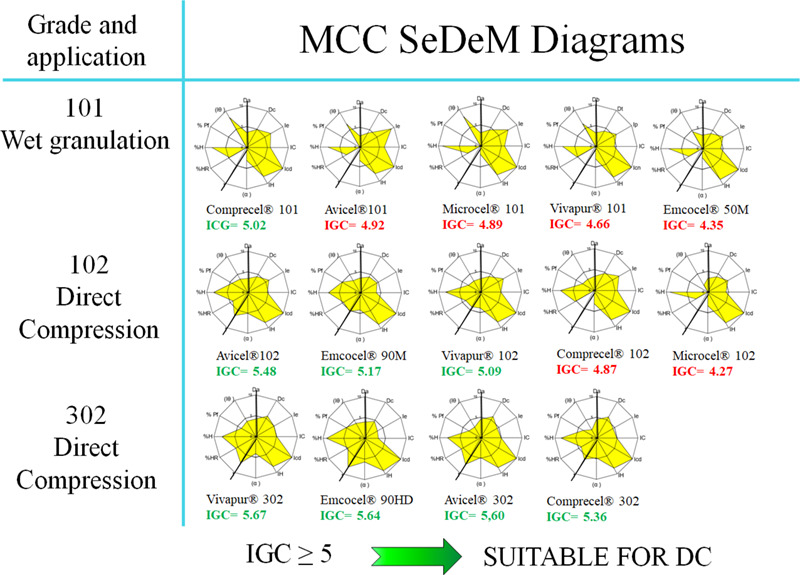Comparison between Microcrystalline Celluloses of different grades made by four manufacturers using the SeDeM diagram expert system as a pharmaceutical characterization tool

The characterization of pharmaceutical powders by means of the SeDeM diagram expert system allows developing a database. This database is a useful tool in pre-formulation steps as initial screening for suitable filler excipients. This study compiles the characterization of 21 powdery Microcrystalline Celluloses (MCC) of different grades (101, 102, 301, 302 and 200) made by four different manufacturers (FMC Biopolymer, Ming Thai Co., Blanver, and JRS Pharma).
The SeDeM characterization led to describing and to analysing the differences between each MCC studied. From this characterization, five Incidence means (Dimensions, Compressibility, Flowability, Lubricity/Stability and Lubricity/Dosage) and the Index of Good Compression (IGC) are calculated. If the IGC is below 5, the SeDeM diagram indicates that the powdery substance is not suitable for direct compression technology. The results show that each manufacturer has its own differences between grades: whereas JRS and FMC Biopolymer have well defined differences for each grade, there are no differences between grades 101 and 102 for Ming Thai products; and Blanver’s grade 102 is less suitable for direct compression than grade 101.
Then, each MCC is compared against the others of the same grade. Although they are usually described by the manufacturers similarly, the results indicate that there may be large differences between them. Finally, the different brands are compared from an overall perspective. The IGC averages for FMC Biopolymer and JRS are acceptable values (above 5). However, Blanver and Ming Thai present deficient values (below 5), though they are still close to the acceptance limit. Thus, it is possible to conclude that the products of JRS and FMC Biopolymer meet the manufacturers’ description and seem to be more suitable (higher IGCs) for direct compression than those of Blanver and Ming Thai.

1. Introduction
MCCs are commonly used as filler/binder in direct compression formulations [1,2] owing to their high “Compressibility” and good/acceptable “Flowability” [[3], [4], [5], [6]]. In consequence, there are a wide variety of manufacturers who produce them by different manufacturing techniques or from different raw materials [[7], [8], [9], [10]]. Likewise, a large number of different MCCs are also available in order to meet all customers’ formulation requirements (different particle size distribution, different bulk density, mixed with other substances, among others). These and other factors such as their crystallinity, raw material, manufacturing technique and country origin could lead to differences during the tableting process [[11], [12], [13], [14], [15], [16], [17], [18]]. Nonetheless, the product description provided by the different manufacturers does not differ greatly from one to another (concerning the same grade).
For instance, four different manufacturers (FMC Biopolymer, Ming Thai Chemical, Blanver, and JRS) offer similar descriptions for their products: grade 101 is described by all four manufacturers as having the finest particle size. It has an average particle size near to 50 μm, except for JRS (65 μm). All the manufacturers suggest this grade for wet granulation, and JRS specifies that its products (Vivapur® 101 and Emcocel® 50 M) have a high compactability. However, this grade is also used in formulations for DC.
This is the reason for including it in this study. The manufacturers describe grade 102 as having a larger average particle size (near to 100 μm for most grades and 130 for JRS’s products) and it is suggested for direct compression. Grades 301 and 302 are described as the same quality as grades 101 and 102, and are therefore recommended for the same procedures, but with a higher bulk density. Grade 200 is described as the largest average particle size (180 μm by most brands, but 220 μm and 250 μm for Emcocel® LP 200 and Vivapur® 200, respectively). Due to its superior flow, the manufacturers describe it as being the excipient of choice to correct the API’s flow deficiencies. Moreover, they suggest this grade for DC because it displays good compactability. It should be pointed out that Ming Thai Chemical does not suggest any application for its grades. It merely describes its products’ characteristics and specifications.
Download full article here: 1-s2.0-s003259101830891x-main.pdf

